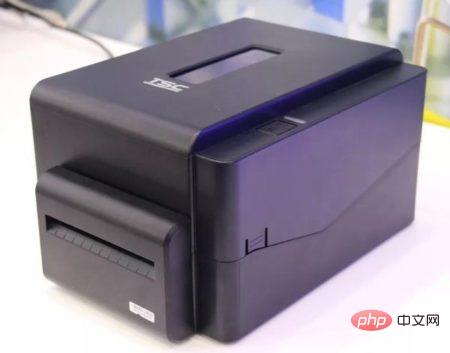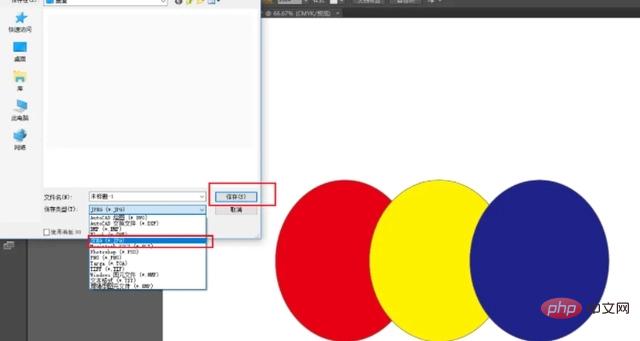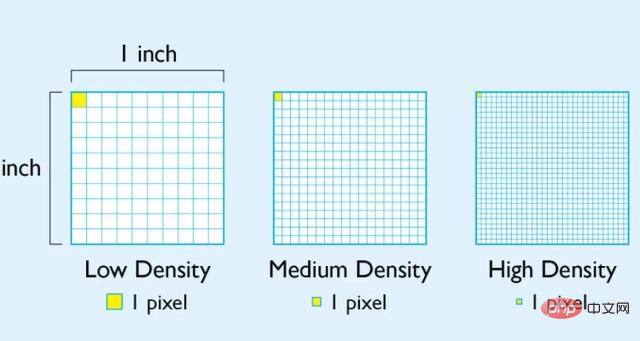What is the relationship between dpi and resolution
dpi is one of the measurement units of resolution, used for dot matrix digital images, which means the number of sampled or displayable or output dots per inch of length. DPI is a unit of measurement for the resolution of printers, mice and other devices. It is an important standard for measuring print quality and a basic indicator for judging printer resolution. Generally speaking, the higher the DPI value, the higher the printing accuracy of the printer.

The operating environment of this tutorial: Windows 7 system, Dell G3 computer.
dpi is one of the units of measurement for resolution.
DPI (Dots Per Inch) is a unit of measurement for dot matrix digital images, which refers to the number of sampled, displayable or output dots per inch of length.
DPI is a unit of measurement for the resolution of devices such as printers and mice. It is one of the main parameters to measure the printing accuracy of the printer. Generally speaking, the higher the DPI value, the higher the printing accuracy of the printer.
DPI refers to pixels per inch, which is the scanning accuracy. The lower the DPI, the lower the resolution of the scan. Due to the influence of network transmission speed, the pictures used on the web are all 72dpi. However, this parameter cannot be used for developing photos. It must be 300dpi or higher 350dpi. For example, if you want to develop a 4*6-inch photo, the scanning accuracy must be 300dpi, then the file size should be (4*300)*(6*300)=1200 pixels*1800 pixels.

#The higher the DPI value of the resolution set by the printer, the finer the printed image will be. Printers can usually adjust the resolution. For example, the resolution of a striker printer is usually 60 to 90 DPI. Inkjet printers can reach 300~720 DPI. Laser printers have 600~1200 DPI.
General monitors are 96 DPI, and the DPI number of bitmaps required for printing depends on the number of printing screen lines. Generally, 150-line printing quality requires a 350 DPI bitmap. And the D (dot) here is the pixel.
Because the color mixing method of the printer is CMYK, the color (that is, the color gamut) performance is not as abundant and vivid as the RGB color light performance of the screen, so the DPI of the printer should be greater than the PPI (Pixels Per Inch) of the monitor. pixels per inch), can achieve the same delicate picture quality as RGB on the screen.

DPI printer resolution refers to the number of dots the printer can print per inch (Dot Per Inch), that is, printing accuracy (DPI), which is a measure of print quality. An important standard and a basic indicator for judging printer resolution. The resolution of printers used by general home users and small and medium-sized office users should be at least between 300DPI and 720DPI, but the bigger the DPI indicator, the better.

Summary: The difference and connection between dpi, pixels and resolution
Pixels and resolution are mainly used for electronic pictures and displays The pixel on the device is the basic unit of image composition, that is, each image is composed of n pixels. The resolution is the number of pixels the image has in length and width. The size of each pixel is not fixed. The resolution is related. Just like a monitor, the pixels are different under different resolutions (1920x1080 has 1024x768 more pixels). The display effect of the same image under different resolutions of the monitor is not very distinguishable (note that it is not shown in the picture above). Yes, you can adjust your own monitor resolution to see the effect) Resolution can also be expressed in terms of dpi (dots per inch, the output resolution of images from printers and copiers) and ppi (pixels per inch, the resolution of electronic display screens).
Extended knowledge: The difference between ppi and dpi
ppi (pixels per inch): The sampling rate of the image (in the image , the number of pixels contained per inch)
dpi (dots per inch): printing resolution (the number of dots that can be printed per inch, that is, printing accuracy)
ppi and dpi are indeed two It’s a concept, but some things are conventional. The ppi of a picture cannot reflect the printing quality that this picture can get in a printing shop. Why don’t you go to the store and give it a try? Ask the operator what you will get if your picture is 72ppi. Most operators will be confused by this kind of printing quality. Only dpi is used in printing shops, because the pictures we take must be output into photos. For the operator, what he needs to know is the pixels of your picture and the size you need to print. These two elements constitute dpi. , so although it is not standardized, we can only use the dpi size to communicate the pictures that need to be printed.
"Getting it into Photoshop and changing it to 300ppi has no practical meaning, and it increases the size of the image." Because such a change is a modification of ppi under a fixed image size (dimension), which results in an inconsistent number of pixels in the image. The real increase will lead to the expansion of the picture size without improving the image quality (the extra pixels are calculated from the difference). The correct way is to first crop your picture according to the proportion of the size you need to enlarge. , then fix the pixels of the picture (remove the check mark in front of "Redefine pixels of the picture") and proportion, and adjust the width and height in "Document Size" to be consistent with the expansion size you want. The ppi that comes out at this time is The dpi that your picture can get at this printing size. If it is lower than 120, it means the printed effect will be poor. 120~200 means the effect is okay. 300 is the best effect. If it is greater than 300, first change the "Redefine" Check the box in front of "Picture Pixels" and then change the ppi to 300 or lower.
(Note: 300dpi is the limit of the printing machine. Pictures larger than 300dpi will not improve the photo clarity. In fact, 250 is enough. Even if you input picture files larger than 300dpi to the printing machine, the printing machine The image will also be calculated to 300dpi before enlarging it. In addition, don’t underestimate the 300dpi of the printing machine. The photo quality of the 300dpi of the printing machine is insurmountable by any printing equipment.)
For more related knowledge, Please visit the FAQ column!
The above is the detailed content of What is the relationship between dpi and resolution. For more information, please follow other related articles on the PHP Chinese website!

Hot AI Tools

Undresser.AI Undress
AI-powered app for creating realistic nude photos

AI Clothes Remover
Online AI tool for removing clothes from photos.

Undress AI Tool
Undress images for free

Clothoff.io
AI clothes remover

Video Face Swap
Swap faces in any video effortlessly with our completely free AI face swap tool!

Hot Article

Hot Tools

Notepad++7.3.1
Easy-to-use and free code editor

SublimeText3 Chinese version
Chinese version, very easy to use

Zend Studio 13.0.1
Powerful PHP integrated development environment

Dreamweaver CS6
Visual web development tools

SublimeText3 Mac version
God-level code editing software (SublimeText3)

Hot Topics
 1387
1387
 52
52
 Another Snapdragon 8Gen3 tablet ~ OPPOPad3 exposed
Jul 29, 2024 pm 04:26 PM
Another Snapdragon 8Gen3 tablet ~ OPPOPad3 exposed
Jul 29, 2024 pm 04:26 PM
Last month, OnePlus released the first tablet equipped with Snapdragon 8 Gen3: OnePlus Tablet Pro. According to the latest news, the "baby-replacement" version of this tablet, OPPOPad3, will also be released soon. The picture above shows OPPOPad2. According to the Digital Chat Station, the appearance and configuration of OPPOPad3 are exactly the same as those of OnePlus Tablet Pro. Color: gold, blue (different from OnePlus’ green and dark gray). Storage version: 8/12/16GB+512GB. Release date: New products for the same period in the fourth quarter of this year (October-December): Find
 A surprise is coming! ViewSonic LX700-4K laser home theater has an official rebate of 1,700 yuan, and a 4K TV box is also included!
Apr 25, 2024 pm 05:49 PM
A surprise is coming! ViewSonic LX700-4K laser home theater has an official rebate of 1,700 yuan, and a 4K TV box is also included!
Apr 25, 2024 pm 05:49 PM
If you are considering buying a projector with cinematic quality that can also accommodate large-screen gaming, the ViewSonic LX700-4K is perfect for you. Not only is it bright, it also has 4K resolution and supports XBOX certification. Currently, it has a great discount, with an official subsidy of 1,700 yuan and a free 4K TV box. Click to purchase: https://item.jd.com/100069910253.html ViewSonic LX700-4K adopts the latest third-generation laser light source technology, which effectively reduces damage to the eyes, allowing you to enjoy the visual feast without worrying about your eyes. damaged. With high brightness of 3500 ANSI lumens and cinematic 4K resolution, every detail is clearly visible, allowing you
 Exquisite light and shadow art in spring, Haqu H2 is the cost-effective choice
Apr 17, 2024 pm 05:07 PM
Exquisite light and shadow art in spring, Haqu H2 is the cost-effective choice
Apr 17, 2024 pm 05:07 PM
With the arrival of spring, everything revives and everything is full of vitality and vitality. In this beautiful season, how to add a touch of color to your home life? Haqu H2 projector, with its exquisite design and super cost-effectiveness, has become an indispensable beauty in this spring. This H2 projector is compact yet stylish. Whether placed on the TV cabinet in the living room or next to the bedside table in the bedroom, it can become a beautiful landscape. Its body is made of milky white matte texture. This design not only makes the projector look more advanced, but also increases the comfort of the touch. The beige leather-like material adds a touch of warmth and elegance to the overall appearance. This combination of colors and materials not only conforms to the aesthetic trend of modern homes, but also can be integrated into
 Easily understand 4K HD images! This large multi-modal model automatically analyzes the content of web posters, making it very convenient for workers.
Apr 23, 2024 am 08:04 AM
Easily understand 4K HD images! This large multi-modal model automatically analyzes the content of web posters, making it very convenient for workers.
Apr 23, 2024 am 08:04 AM
A large model that can automatically analyze the content of PDFs, web pages, posters, and Excel charts is not too convenient for workers. The InternLM-XComposer2-4KHD (abbreviated as IXC2-4KHD) model proposed by Shanghai AILab, the Chinese University of Hong Kong and other research institutions makes this a reality. Compared with other multi-modal large models that have a resolution limit of no more than 1500x1500, this work increases the maximum input image of multi-modal large models to more than 4K (3840x1600) resolution, and supports any aspect ratio and 336 pixels to 4K Dynamic resolution changes. Three days after its release, the model topped the HuggingFace visual question answering model popularity list. Easy to handle
 Enable or disable automatic super-resolution (ASR) in Windows 11
Mar 14, 2024 pm 01:40 PM
Enable or disable automatic super-resolution (ASR) in Windows 11
Mar 14, 2024 pm 01:40 PM
Windows 11 introduces a new feature called automatic super-resolution, which uses artificial intelligence technology to make supported games run more smoothly on the system, thereby improving the user's gaming experience. This article will introduce how to enable or disable the automatic super-resolution (ASR) function in Windows 11. Automatic super-resolution using artificial intelligence technology can improve the visual detail and resolution of games, converting low-resolution images into clearer high-resolution images. Automatic super-resolution is currently in beta and therefore only available in InsiderBuild. You need to install Windows 11 build 26052 or higher to use this feature. You can check your Windows 11 version by following these steps
 Colorful Hidden Star P15 24 Review: A hard-core all-round gaming laptop with both good looks and performance
Mar 06, 2024 pm 04:40 PM
Colorful Hidden Star P15 24 Review: A hard-core all-round gaming laptop with both good looks and performance
Mar 06, 2024 pm 04:40 PM
In the current era of rapid technological development, laptops have become an indispensable and important tool in people's daily life and work. For those players who have high performance requirements, a laptop with powerful configuration and excellent performance can meet their hard-core needs. With its excellent performance and stunning design, the Colorful Hidden Star P15 notebook computer has become the leader of the future and can be called a model of hard-core notebooks. Colorful Hidden Star P1524 is equipped with a 13th generation Intel Core i7 processor and RTX4060Laptop GPU. It adopts a more fashionable spaceship design style and has excellent performance in details. Let us first take a look at the features of this notebook. Supreme equipped with Intel Core i7-13620H processing
 Realme GT6 See you next week! Super light and shadow engine blessing, comprehensive upgrade of communication capabilities
Jul 10, 2024 pm 06:36 PM
Realme GT6 See you next week! Super light and shadow engine blessing, comprehensive upgrade of communication capabilities
Jul 10, 2024 pm 06:36 PM
Following realme’s official announcement some time ago that it will release the Realme GT6 mobile phone next week, the official announced the main configuration parameters and appearance pictures of the new phone. Today, Realme officially warmed up the system and images of the new phone again. Preheating information shows that the Realme GT6 is equipped with the new realmeUI5.0 system, which provides 4 years of system update maintenance and 3 major Android version updates, claiming that the system experience is "reborn". The editor briefly summarized the updated functions of realmeUI5.0. Highlights include: new fluid cloud interaction and Car + car connection functions; introduction of transfer stations for cross-application content flow, optimization of workbench and text recognition functions; new privacy watermarks and improved permissions. Management; improve system stability and application startup speed; upgrade water
 The screen is good for playing games. Brief analysis of iQOO Neo9S Pro+ screen
Jul 19, 2024 pm 03:53 PM
The screen is good for playing games. Brief analysis of iQOO Neo9S Pro+ screen
Jul 19, 2024 pm 03:53 PM
In today's smartphone market, screen quality has become one of the key indicators to measure the overall performance of a mobile phone. iQOO's Neo series has always been committed to providing users with excellent gaming experience and visual enjoyment. The latest product iQOO Neo9SPro+ uses a "Three Good Eye Protection Gaming Screen". Next, let's take a look at the quality of this screen. How brilliant. iQOO Neo9S Pro+ is equipped with a 1.5 KOLED e-sports direct screen, which supports flagship LTPO adaptive refresh rate from 1Hz to 144Hz, which means that it can achieve ultra-low power standby state when displaying static content, and it can also be intelligent during gaming. Switch to dynamic high from 90Hz to 144Hz




